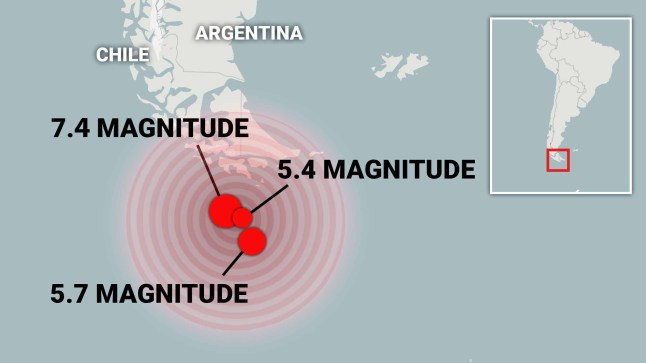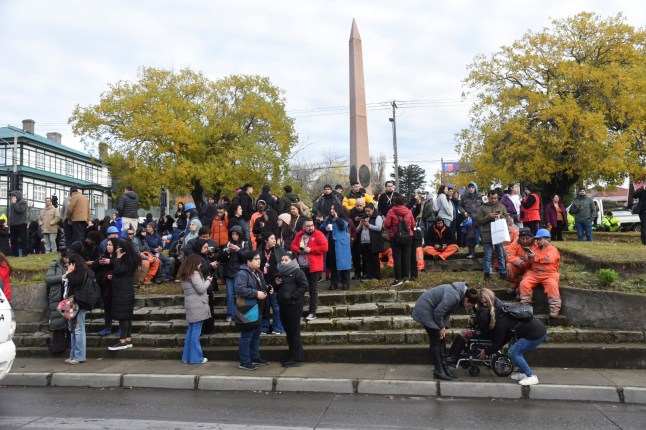
A huge 7.4 magnitude earthquake struck the south of Argentina and Chile, prompting fears of a tsunami.
The southern coastal region of Chile was ordered to be evacuated, with tsunami waves forecast to be as high as three metres in some areas.
The earthquake struck at 9.58am local time, about 136 miles south of Ushuaia on the southern tip of Argentina, in the Drake Passage.
The US Geological Survey (USGS) said the quake was magnitude 7.4, below the 7.5 reported by Chile’s National Seismological Centre.
Chilean officials later cancelled the evacuation order, but asked people to stay clear of beaches.
‘The preventive evacuation is over. That means everyone can return and resume their activities,’ said. Juan Carlos Andrade, director of the state disaster agency in the remote southern Magallanes region,
To view this video please enable JavaScript, and consider upgrading to a web
browser that
supports HTML5
video
If a tsunami did occur, it could have generated waves as high as 10 feet and could reach the Golfo de Penas, according to the US Tsunami Warning System.
Aftershocks as high as 5.7 magnitude have been recorded in the hours since. These smaller quakes, typically along the portion of the fault that slipped to cause the main tremor, can occur weeks after.
SENAPRED, Chile’s disaster agency, declared a Red Alert and ordered the evacuation of the Magallanes Region and Chilean Antarctica, affecting nearly 2,000 people.
No casualties or damage have yet been reported from the quake.
Tsunami warning sirens sounded in the Chilean port town of Puerto Williams, which is 135 miles from the quake’s epicentre.

Other evacuated areas included Puerto Natales, Future, Green River, Punta Arenas, Prat Base (Chilean Antarctica) and O’Higgins Base (Chilean Antarctica).
Residents in Punta Arena quickly filled the streets after the evacuation order, carrying suitcases and looking for shelter.
People living on the southern edge of South America have been urged to move away from the coast and to higher ground due.
To view this video please enable JavaScript, and consider upgrading to a web
browser that
supports HTML5
video
How is the size of an earthquake measured?
Magnitude is the size of the earthquake, and is expressed as a number.
The U.S. Geological Survey (USGS) explains on its website that the time, location, and magnitude of an earthquake can be determined from the data recorded by a seismometer, which records the vibrations that travel through the Earth.
According to USGS, a magnitude 5.3 is a moderate earthquake while a magnitude 6.3 is a strong earthquake.
‘Because of the logarithmic basis of the scale, each whole number increase in magnitude represents a tenfold increase in measured amplitude as measured on a seismogram,’ it says.
Chile’s government has convened The National Disaster Risk Management Committee (COGRID) to coordinate a response to the earthquake.
The country’s President Gabriel Boric joined urgent calls for coastal communities to leave the seafront.
He wrote on X: ‘We are calling for the evacuation of the coastline throughout the Magallanes region.
‘Right now, our duty is to be prepared and heed the authorities.’
The earthquake was felt strongly in the Argentine city of Ushuaia, considered the world’s southernmost, although no damage or evacuations were reported.
All types of water activities and navigation in the Beagle Channel, where Ushuaia is located, for at least three hours.

The local government said: ‘The earthquake was felt primarily in the city of Ushuaia and, to a lesser extent, in towns across the province.
‘In the face of these types of events, it is important to remain calm.’
The German Research Center for Geosciences (GFZ) said that a magnitude 7.3 earthquake struck Drake Passage between Cape Horn and Antarctica.
The Drake Passage is the stretch of ocean between South America’s Cape Horn and the South Shetland Islands of Antarctica.
This 7.5 magnitude earthquake comes just a month after Myanmar was hit by a 7.7 magnitude quake.
The resulting disruption in Myanmar and neighbouring Thailand saw over 3,000 dead and 200,000 people displaced.
Get in touch with our news team by emailing us at webnews@metro.co.uk.
For more stories like this, check our news page.